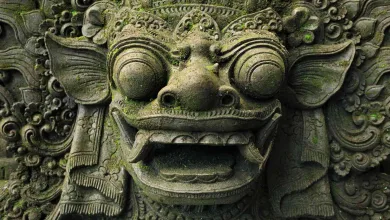Transcendental Meditation
Transcendental Meditation, popularly known as TM, typically would be considered a New Age religion (see chapter 39). For its size and popularity, it will be covered in a brief chapter of its own.
The movement and related organizations were founded by Maharishi Mahesh Yogi. He was born in northern India in 1917 (some sources say 1911, others 1918) and earned a university degree in physics before renouncing worldly pursuits to become a disciple of Swami Brahmananda Saraswati, better known as Guru Dev. Following Guru Dev’s death in 1953, Maharishi (a Hindi title meaning “great seer”) continued to meditate and reflect, including two years spent in a Himalayan cave. These meditations on Guru Dev’s teachings became the basis for TM.

Maharishi Mahesh Yogi moved to the U.S. in 1958 and founded the Spiritual Regeneration Movement in Los Angeles. Although the initial response was small, the antiestablishment mood of American youth in the later 1960s produced an interested audience for his message of peace and tranquility. The Beatles began to follow him, even spending time at his ashram (meditation and training center) in India, and this publicity brought rapid growth.
After a few years, there was a falling-out with the Beatles, especially John Lennon, who called Maharishi “a lecherous womanizer.” (George Harrison continued to practice Hinduism; his former estate outside London is now a Hindu temple and retreat center.) The adverse publicity brought a decline in numbers, and in the early 1970s Maharishi returned to India.
But before long he was back in the U.S. He rebranded TM as the Science of Creative Intelligence (SCI), replacing all religious vocabulary with terms from psychology; the movement began to grow again. So great was the popularity of TM seminars (people paid $2,500 or more to attend) that in the 1970s, SCI was making up to $20 billion annually. In 1974, Maharishi bought the former Parsons College in Fairfield, Iowa, and founded the Maharishi International University.
Through the university’s research, TM sought to demonstrate the scientific basis of Transcendental Meditation, further distancing itself from allegations of religious teaching. For a time TM found its way into public schools, but in 1977, a federal court ruled that SCI/TM was indeed religion-based and banned it from being taught in New Jersey public schools. Some other states quickly adopted similar provisions, despite TM’s loud and frequent protests.
This by no means brought an end to TM, which continues to advertise widely and grow through seminars offered all over the country. “I lowered my blood pressure naturally through TM,” proclaims one advertisement, quoting the American Journal of Cardiology. It goes on, “Learn how Transcendental Meditation® can unfold perfect health and improve your quality of life.” In a tacit admission of TM’s religious basis, the fine print attributes the ad to the Maharishi Vedic Education Development Corporation.

The death of Maharishi Mahesh Yogi, in 2008, also did little to slow the growth of TM and its expanding number of related organizations. Currently, plans are in place to build Peace Palaces in three thousand major world cities. According to the website, “Each Peace Palace will offer to everyone the knowledge and practical programs for peace and enlightenment, for a healthy, happy, more creative, more fulfilling and successful life through the Transcendental Meditation program. Its benefits in the fields of education, health, social behavior, and world peace have been amply documented during the past half-century all over the world” (maharishipeacepalace.org [04/18/12]).
Another organization, The Global Country of World Peace, aspires to assist current governments “by unifying all nations in happiness prosperity, invincibility, and perfect health” (www.globalcountry.org/wp/the-global-mother-divine-organization/ [04/18/12]). The administrators of various countries within the GCWP are called rajas. According to the Minneapolis Star Tribune, the cost of training to become a raja is $1 million. Rajas may have “vedic authority” over physically disparate political entities—Graham de Freitas, PhD, is raja of Minnesota, Norway, Grenada, Trinidad, and Tobago, and half a dozen African countries.
Transcendental Meditation itself is a procedure for reaching a state of “higher consciousness,” releasing the practitioner’s innermost potential. Unlike other forms of meditation, TM is supposed to transcend thinking. The basic techniques are taught in a seven-step course, currently costing $1,500. The Maharishi Foundation claims to have trained more than six million people worldwide over the past fifty years.
Training includes giving the initiate a mantra, a word repeated while meditating. The primary requirement is relaxing while repeating the mantra for twenty minutes, twice daily. Advanced courses promise to move a person beyond transcendental consciousness to cosmic consciousness, God consciousness, and eventually unity consciousness, where one achieves complete unity with God and freedom from karma. These deeper levels show TM’s connection to Hindu philosophy and worldview.
An Extra Minute
In July 2006, Professor John Hagelin, a theoretical physicist at the Maharishi University, began a yearlong experiment in bringing worldwide peace and prosperity through group meditation. The goal was to gather more than two thousand TMers to meditation twice a day for three hours each session. Expectations included an end to the war in Iraq and a rise in the Dow Jones Industrial Average. The DJIA was just over 11,000 in July 2006. By July 2007, it was almost 14,000. One year later it was back at 11,000 again.

TM Transcendental Meditation
TM Transcendental Meditation
TM Transcendental Meditation
SCI Science of Creative Intelligence
TM Transcendental Meditation
TM Transcendental Meditation
SCI Science of Creative Intelligence
TM Transcendental Meditation
TM Transcendental Meditation
TM Transcendental Meditation
TM Transcendental Meditation
TM Transcendental Meditation
TM Transcendental Meditation
TM Transcendental Meditation
TM Transcendental Meditation
TM Transcendental Meditation
Morgan, G.R. (2012) Understanding World Religions in 15 Minutes a Day. Minneapolis, MN: Bethany House Publishers, pp. 170–173.



